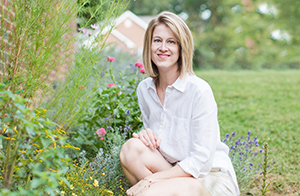When I was first starting out, growing from seed seemed daunting, but with a few tips and the right equipment, it’s pretty easy. Right now, lots of people are trying to figure out how to start seeds indoors, so I thought I would answer the top questions about it.
When to start seeds indoors?
When to plant seeds seems to trip people up the most. There are several ways to figure out how to do this.
Follow Seed Packets
You can follow the directions on the seed packet. If the packet doesn’t say, which happens a lot and is frustrating, you can look it up on the manufacturer’s website. It should tell you to start indoors, plant ___ weeks prior. That means that you want to plant the seeds however many weeks prior to your last spring frost date. If you don’t know your frost date, find it here. I go by April 24th. So if a seed packet says 6 weeks prior, that would be March 13th for me.
Then, I simplify. If my tomatoes all have different dates — 6 weeks, 7 weeks, 8 weeks — I will start them all 7 weeks prior to make it easier.

Follow local seed starting guides
The other way you can figure out when to plant is to follow local seed starting guides. This is easier than researching tons of seeds packets. Your best bet is to check with your local extension service. For me, that’s through Virginia Tech. [7a planting guide] I also really like the guide that Southern Exposure seed company provides as they are close to me in Virginia. [Southern Exposure Recommended Planting Dates]

Seed Starting Timeline Guide
This is a seed starting guide of what to do for many popular spring/summer vegetables and flowers. I have come up with this based on seed packets, the extension planting calendar, my own experience and trying to simplify. The timing can vary a little bit, this is just the way I do it. You can start indoors or direct sow starting in early spring and I have listed both ways to do it.
OUTDOORS – direct sow
8 weeks prior – peas
7 weeks prior – radishes, parsnips
6 weeks prior – carrots, greens (chard, lettuce, spinach, arugula, kale, collards), broccoli, cabbage
4 weeks prior – spinach
On frost date – pole or bush beans, most flowers (cosmos, zinnias, sunflowers, marigold, calendula), tomatoes, peppers, eggplant, herbs
2 weeks PAST frost date – cucumbers, squash, watermelon, cantaloupe
(bolded above are seeds that are best to direct sow, many would say cucurbits belong here but I have good luck starting them inside)
INDOORS – start in seedling trays or small pots
11 weeks prior – kale, collards, swiss chard (transplant 6 weeks prior)
10 weeks prior – eggplant (transplant on or after frost date)
9 weeks prior – lettuce (transplant 6 weeks prior)
8 weeks prior – peppers (transplant on or after frost date)
8 weeks prior – broccoli (transplant 2 weeks prior to frost date)
7 weeks prior – tomatoes, most herbs (transplant on or after frost date)
7 weeks prior – cabbage (transplant 3 weeks prior to frost date)
6 weeks prior – cosmos, zinnias, marigolds, calendula (transplant on or after frost date)
4 weeks prior – cucumbers, squash, watermelon, cantaloupe (transplant 2-3 weeks after frost date)
How to implement the seed starting timeline
You can print out a calendar or use any calendar you have. Or, if you’re more digital, create a Google calendar. I have a separate one just for garden related things. First I mark the frost date on the calendar. If you don’t know your frost date, find it here. Then, I go backwards and mark 1 week prior, 2 weeks prior and so on. If my frost date is during the week, I move it forward a few days or backwards a few days to a weekend date. That way all of my to-do items are on the weekend when I can actually do them.
Next, depending on what you want to plant, mark on your calendar what day to start plants indoors using my list above. I used a different color for all of these entries.
Then, mark when to transplant in another color and when to direct sow outdoors with yet another color.
That’s it! You have your plan of action now. It’s color-coded and it’s on your phone. I print a copy to leave at my seed starting station.
The next thing that I do is mark when I actually did all of these things, because life happens and weather changes things. I use this as a garden journal and note everything. When things germinate, when I have problems, when intervention is used, when I fertilize, etc.


Starting Seeds Indoors vs. Outdoors
Whether to start indoors or direct sow in the garden is a personal choice. The reason for starting indoors is to get a head start on the growing season and get everything fruiting sooner. Especially for those of us with harsh winters. This is less of a problem for people with milder climates that can grow more things year-round.
I like to start as much as I can indoors because I want to see flowers sooner and I want to eat tomatoes sooner. I have made the mistake of planting too early and then having to cover plants every night. It’s a pain. I now err on the side of caution when transplanting to make sure all danger of frost has passed, sometimes a week or two after others will plant. Because I start my warm weather plants inside, I am not behind on the growing season at all by doing this.
Another reason I start some things indoors is because I can’t plant outdoors quite yet because I have others things still growing there. So, for example, I can’t direct sow my zinnias on the frost date because I have spring flowers growing where they will grow (tulips, ranunculus, poppies, etc.). So, if I didn’t start them indoors, I would be way behind by direct sowing several weeks after the frost date whenever the other flowers finished blooming. It’s more challenging to be a three-season gardener and balance all of this.
If you don’t have room or money to buy lights, don’t worry about it, just direct sow everything.
As a general rule of thumb, the things you absolutely do not want to start indoors and transplant are any root vegetable. The roots can’t be disturbed. So, that’s radishes, carrots, parsnips, etc. Everyone says not to transplant cucumbers and squash, but I have pretty good luck doing it. I start them in larger pots, so that I don’t have to pot up, thereby disturbing them less.
On the flip side, I would never plants beans indoors, because they grow so fast and it’s so much easier to direct sow.

What you need to grow indoors
- Large flat surface or shelfing unit – You will need the space this shelf provides.
- Trays – 1020 trays without holes. Only buy heavy-duty ones because the flimsy ones are useless once the plants are bigger. These trays from Bootstrap Farmer are the best and will last forever. You will put your planting trays or pots in here to bottom water.
- Humidity Dome – You will need to put this over the trays until the seeds germinate. I love this one from Bootstrap Farmer.
- Planting trays, small pots or any plastic containers (solo cups, whatever you have). I save all of the plastic pots that I get from nurseries and I bought some smaller seed starting trays.
- Seed starting mix or potting soil – You’re supposed to use a sterile seed starting mix, but I have better luck with regular potting soil.
- Lights – shop type lights, LED, specific grow lights – There are lots of options. I will link some below.
- A way to hang your lights – Sometimes, you have to make a simple frame for the lights. And, then you need rope or chains to hang them. I use pulleys on rope and chains with hooks.
- Seed warming mat with timer – Some seeds require higher temperatures to germinate. Warming mat.
- Fans – Having some movement and wind will help recreate the environment outside and make your seedlings stronger. I like this small clip-on fan.

How to set up your seed-starting lights
The lights I buy come in a bundle of 6-10 and they need to be mounted to something. I have used thin pieces of wood (furring strips) and plastic pipe to do this.
Measure the space where you will put your lights and then make a simple frame.
What you’ll need
- 1x2x8′ furring strips or PVC pipe (cut to size)
- eye bolts and rope and pulleys OR mesh chain and hooks



Rope Method: To hang the lights, you can use a rope. I also use a pulley which allows me to lower or raise the lights depending on the height of the plants. You always want the lights a few inches above the plants. (The lights came with the silver brackets to attach.)

For my rope set up, I have the rope hanging from the rafters above. It is easier to hang the lights with a wire shelving unit, which I also use.

Chain Method: You can use fine mesh chain with hooks to raise or lower the lights. The chain simply attaches to the shelf above.

Starting Seeds
This is the easy and fun part.
- Fill your seed trays or pots with the starter mix or potting soil.
- Write the name of the plant on plant markers and place them before planting the seed. This is important! With so many seeds and pots, you can confuse yourself quickly. Mark first and then add the seed.
- Consult the seed packet for the planting depth. I usually just press my finger into the soil a little and then scoot the dirt over to cover it.
- Water them.
- Cover with a humidity dome or plastic wrap. This is not strictly necessary, but it can help with germination.
- Once they sprout, make sure your lights are on. The lights need to be on at least 12 hours per day, but the plants will grow the best with 16-18 hours per day.

Seed Organization
For more information about how I organize my seeds, see this post.






No Comments